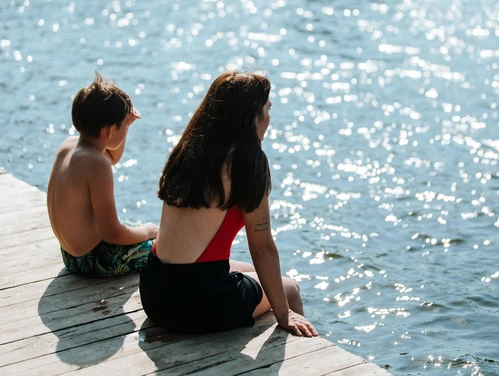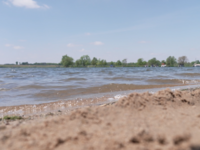State Park Swimming & Beach Use
All swimming shall take place between sunrise and sunset at Iowa state parks. Beach use and swimming is prohibited between sunset and sunrise.
Swimming must be done in the designated beach area within the boundaries marked by ropes, buoys or signs. Swimmers may swim outside of the designated beach area under the following conditions:
- Swimming must take place between sunrise and sunset.
- Swimmers must be accompanied by a person operating a vessel and must stay within 20 feet of the vessel at all times during the swim.
- The vessel accompanying the swimmer must display a flag, which is at least 12 inches square, is bright orange and is visible all around the horizon.
- The person swimming must register with the park staff in charge of the area and sign a registration immediately prior to the swim.
- Inner tubes, air mattresses and other beach toy-type items may be used only in the beach areas.
Swimming Safety
Swimming is a life-saving, life-long healthy activity that makes time near water enjoyable.
- Wear a lifejacket. Always wear a properly fitted, personal floatation device (PFD). Make sure kids wear their life jackets before getting in the water.
- Refresh your swimming skills. If you haven’t swam in a long-time, refresh your abilities. And all ages—tots to elders—can learn to swim.
- Learn to swim if you can't. Instructors make learning relaxing, especially for those who fear the water. Inquire at municipal pools, colleges or YMCA facilities or with a private instructor. All children should learn to swim with formal lessons.
- Avoid obstacles in the water. Watch for downed trees, concrete, scrap metal, currents, high water, and more. These pose a danger and can make your swimming adventure dangerous or fatal.
- Alcohol and drugs impair judgment. Alcohol is a factor in more than half of drownings.
- Avoid areas near dams. Low-head dams and roller currents at dams are dangerous and can result in death.
- Watch children at all time. Watch young children when swimming or playing near water. Drowning can occur quickly and quietly. Be close enough to touch the child at all times, even in ankle-deep water.
- Learn CPR. CPR bystanders can save lives and improve outcomes for near-drownings. The quicker CPR beings, the better the results. Talk to your local hospital, workplace, or doctor's office about CPR classes.
Water Quality Monitoring
Before your trip to an Iowa beach, check the water quality on our beach monitoring website.
Boat & Vessel Swimming
Unless otherwise posted as prohibited or limited to the designated beach area, persons may swim within 10 feet of a vessel anchored not less than 100 yards from the shoreline or the marked boundary of a designated beach area.
All vessels, except those being uprighted or repaired, must be attended at all times by at least one person remaining on board. Scuba diving may occur outside of the designated beach area, provided the divers flag is displayed as specified in rule 571-41.10 (462A).
Prohibited Items on Beaches
- Alcoholic liquors are not to be consumed in parks, recreation areas and forests. This includes hard liquors (whiskey, vodka, etc.).
- Possession or use of glass or other breakable containers, fragments of which could cause injuries, is prohibited within the designated beach areas.
- Animals are prohibited within the designated beach area.
- At Brushy Creek State Recreation Area, located in Webster County and Pleasant Creek State Recreation Area, located in Linn County, swimming is prohibited from 10:30 p.m. to 6 a.m. daily.
Swimming Registration
Effective May 13, 2009, persons may swim outside the designated swimming beach under certain conditions. A swimmer must register with park staff in charge of the area and sign a registration prior to the swim. Each swimmer must complete his/her own Swimming Outside of Designated Swimming Beach, Registration Form.

